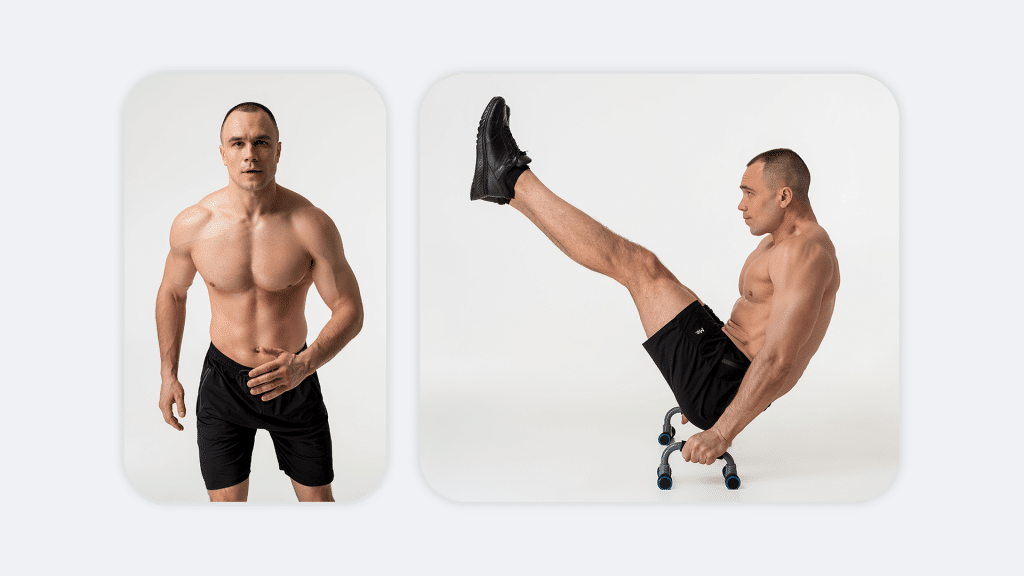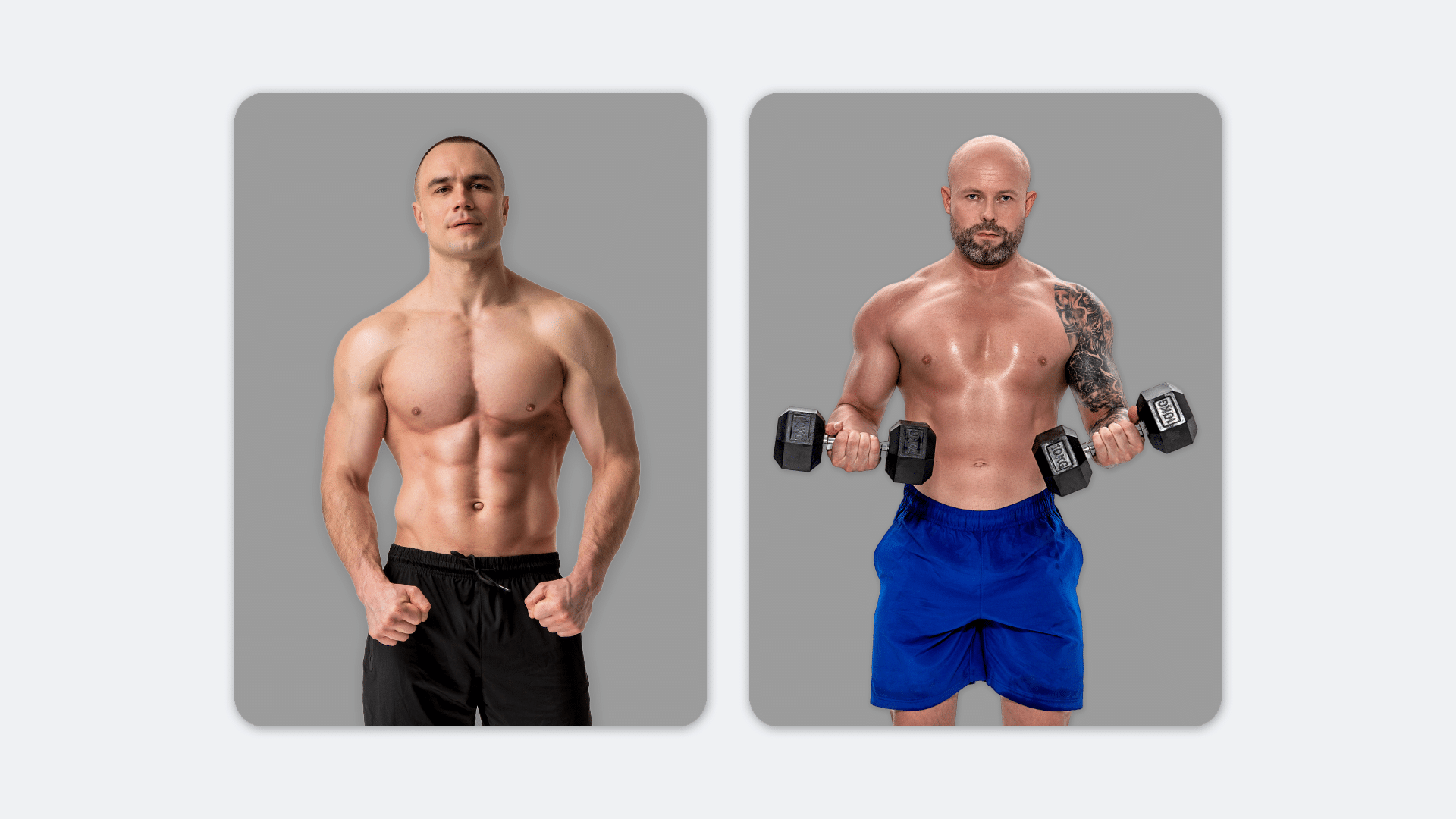You’re about to uncover the fascinating world of fitness and exercise as we explore the distinction between calisthenics and bodyweight exercises. If you’ve ever wondered what sets these two forms of training apart, get ready for a dose of clarity. In this article, we’ll break down the key differences between calisthenics and bodyweight exercises, giving you a deeper understanding of each and helping you decide which approach suits your fitness goals best. So, let’s lace up our sneakers and embark on this enlightening journey together!

This image is property of betterme.world.
Definition of Calisthenics and Bodyweight Exercises
Calisthenics
Calisthenics refers to a form of exercise that primarily utilizes bodyweight movements to build strength, flexibility, and endurance. These exercises are performed using little to no additional equipment, making it a versatile and accessible fitness option for individuals of all fitness levels. Calisthenics exercises typically involve movements such as push-ups, pull-ups, squats, lunges, and planks, which engage multiple muscle groups and promote functional fitness.
Bodyweight Exercises
Bodyweight exercises, on the other hand, are a broader category that encompasses any exercise that utilizes the weight of your own body as resistance. This includes traditional calisthenics exercises, but also extends to other movements such as yoga, Pilates, and gymnastics. Bodyweight exercises can be performed with or without additional equipment, but the focus remains on using the body’s own weight to challenge and strengthen muscles.
History of Calisthenics and Bodyweight Exercises
Calisthenics
The term “calisthenics” originated from the ancient Greek words “kalos” meaning beauty and “sthenos” meaning strength. It was during the 19th century that calisthenics gained popularity, becoming a structured form of exercise promoted for physical and mental wellbeing. Initially, calisthenics exercises were mainly used by the military to improve the fitness levels of soldiers. However, as awareness of the benefits of calisthenics grew, it became embraced by the general public as a means of staying in shape.
Bodyweight Exercises
Bodyweight exercises have been a part of human history for centuries, with ancient civilizations like the Greeks and Romans incorporating them into their training routines. They were often used as a preparation for various physical activities, including combat and sports. Over time, bodyweight exercises evolved and were adopted by different cultures, with practices like yoga and gymnastics integrating bodyweight movements into their respective disciplines. Today, bodyweight exercises continue to be a popular form of exercise worldwide due to their accessibility and effectiveness.

This image is property of staticg.sportskeeda.com.
Workout Equipment
Calisthenics
One of the main attractions of calisthenics is its minimalistic and equipment-free nature. In general, calisthenics exercises rely solely on the weight of your body and the use of gravity to increase resistance. This means that you can perform calisthenics workouts anytime and anywhere without the need for expensive gym memberships or specialized equipment. While some calisthenics enthusiasts may incorporate simple equipment like resistance bands or suspension trainers to add variety to their routines, they are not a necessity.
Bodyweight Exercises
Like calisthenics, bodyweight exercises can be performed without the need for extensive equipment. However, depending on the specific type of bodyweight exercise you choose, certain equipment may enhance your workouts. For example, practicing yoga may require a yoga mat, blocks, and straps to improve stability and form. Similarly, advanced gymnastics movements may require specialized equipment like rings, bars, or parallel bars. However, these additional equipment options are not essential for engaging in bodyweight exercises, making them an accessible fitness option for all.
Muscle Groups Targeted
Calisthenics
Calisthenics exercises are designed to engage multiple muscle groups simultaneously, providing a full-body workout. The primary muscle groups targeted during calisthenics workouts include the chest, shoulders, back, arms, core, and legs. For instance, exercises like push-ups and dips primarily work the chest, shoulders, and triceps, while pull-ups and rows target the back and biceps. Furthermore, squats and lunges effectively engage the leg muscles, and plank variations engage the core muscles.
Bodyweight Exercises
Similar to calisthenics, bodyweight exercises focus on engaging multiple muscle groups. However, the specific muscle groups targeted can vary depending on the type of bodyweight exercise being performed. For example, yoga poses mainly target flexibility, balance, and stability, working muscles throughout the body to maintain poses and transitions. Pilates exercises focus on core strength, promoting stability and alignment while working muscles such as the abdominals, glutes, and lower back.

This image is property of betterme.world.
Benefits of Calisthenics and Bodyweight Exercises
Calisthenics
Calisthenics offers numerous benefits, making it a popular fitness choice among individuals of all fitness levels. Firstly, calisthenics exercises improve overall strength, as they require the muscles to work against the resistance of bodyweight. This can lead to increased muscle tone and definition. Additionally, calisthenics improves flexibility and joint mobility due to the full range of motion required during exercises such as lunges and squats. Moreover, calisthenics workouts enhance cardiovascular fitness and endurance, especially when performing exercises in a high-intensity interval training (HIIT) format.
Bodyweight Exercises
Bodyweight exercises, including calisthenics, provide a wide range of benefits for both physical and mental wellbeing. Firstly, they offer convenience and accessibility since they can be performed anywhere with little to no equipment. This makes it easier for individuals to maintain an active lifestyle without the need for gym access. Secondly, bodyweight exercises promote functional fitness, as they mimic everyday movements and improve balance, coordination, and body awareness. Finally, bodyweight exercises have been shown to improve mental health by reducing stress, boosting mood, and increasing self-confidence through physical achievements.
Training Intensity and Difficulty
Calisthenics
Calisthenics exercises can be tailored to suit individuals of all fitness levels by adjusting the intensity and difficulty of the movements. Beginners can start with basic exercises such as assisted push-ups or squats, gradually increasing the intensity as they become stronger. Intermediate and advanced practitioners can challenge themselves with advanced variations like muscle-ups or pistol squats. Furthermore, by incorporating plyometric movements or performing exercises in a circuit format, the intensity of calisthenics workouts can be increased, providing a challenging and effective workout.
Bodyweight Exercises
Similar to calisthenics, bodyweight exercises offer a wide range of intensity and difficulty options to accommodate different fitness levels. For beginners, modified versions of exercises, such as knee push-ups or assisted lunges, can be employed to build strength and proper form. As individuals progress, they can increase the difficulty by performing exercises with correct technique, increasing repetitions, or incorporating variations that require greater strength or flexibility. Furthermore, integrating different styles of bodyweight exercise like yoga or Pilates can provide a low-impact yet challenging workout option.

This image is property of cdn.shopify.com.
Exercise Variation and Creativity
Calisthenics
Calisthenics exercises offer a multitude of variations and creative possibilities, allowing individuals to constantly challenge themselves and keep workouts engaging. For example, push-ups can be performed with different hand placements, such as wide or narrow grip, to target specific muscle groups. Moreover, the addition of movements like handstands, human flags, or planche progressions can provide an advanced level of intensity and further enhance strength and skill development. Calisthenics encourages experimentation and fosters an environment of innovation, making it an exciting and dynamic approach to fitness.
Bodyweight Exercises
Similarly to calisthenics, bodyweight exercises provide a diverse range of movements and styles that can be incorporated into workouts. For instance, yoga offers various poses and sequencing, allowing individuals to customize their practice and cater to specific fitness goals or preferences. Additionally, Pilates exercises can be modified and combined to create challenging routines that focus on specific muscle groups or target overall core strength. The versatility of bodyweight exercises allows for endless creativity in customizing workouts according to individual needs and preferences.
Training Goals and Objectives
Calisthenics
Calisthenics can be used to achieve a wide variety of training goals, ranging from increasing strength and muscle mass to improving flexibility and mobility. For individuals looking to build muscle, the progressive overload principle can be applied by gradually increasing the difficulty of exercises or incorporating additional resistance through weighted vests or resistance bands. On the other hand, individuals aiming to improve flexibility can incorporate dynamic stretching or mobility exercises into their calisthenics routines. Calisthenics provides the flexibility to focus on specific goals while still promoting overall fitness and functional movement.
Bodyweight Exercises
As with calisthenics, bodyweight exercises cater to a diverse range of training goals and objectives. For individuals seeking to develop core strength and stability, Pilates exercises can be highly effective. On the other hand, individuals aiming to improve flexibility and mindfulness may find practices like yoga particularly beneficial. Bodyweight exercises also offer opportunities for cardiovascular training through high-intensity interval workouts or incorporating elements of cardio-focused exercises like burpees or mountain climbers. The adaptability and versatility of bodyweight exercises make them a valuable tool for achieving a wide range of fitness objectives.

This image is property of lanegoodwin.com.
Progression and Advancement
Calisthenics
Progression and advancement in calisthenics are achieved by gradually increasing the difficulty of exercises as you become stronger and more skilled. This can be done by performing exercises with strict form and range of motion, increasing repetitions, or incorporating more challenging variations. For example, individuals who have mastered traditional push-ups can progress to one-arm push-ups or planche variations to continue challenging their muscles. Calisthenics provides a clear path for progression, allowing individuals to constantly push their limits and achieve new milestones.
Bodyweight Exercises
Progression and advancement in bodyweight exercises require a similar approach to that of calisthenics. As individuals become more proficient in basic movements, they can gradually increase the difficulty by performing more challenging variations or progressing to more complex exercises. In yoga, this may involve moving from beginner poses to more advanced inversions or balances. In Pilates, individuals may gradually increase the complexity of exercises by incorporating props or focusing on engaging deeper layers of muscles. The continual progression in bodyweight exercises ensures that individuals never plateau and are constantly motivated to improve.
Conclusion
In conclusion, both calisthenics and bodyweight exercises offer a wide range of benefits and training options. Calisthenics focuses on using bodyweight movements to build overall strength, flexibility, and endurance, while bodyweight exercises encompass a broader category of exercises that utilize the weight of the body as resistance. Both forms of exercise can be performed without extensive equipment, making them accessible to individuals of all fitness levels. Whether you choose calisthenics or bodyweight exercises, both provide opportunities for progression, creativity, and achievement. So get moving and discover the joy of working out using your own body as your ultimate fitness tool.





